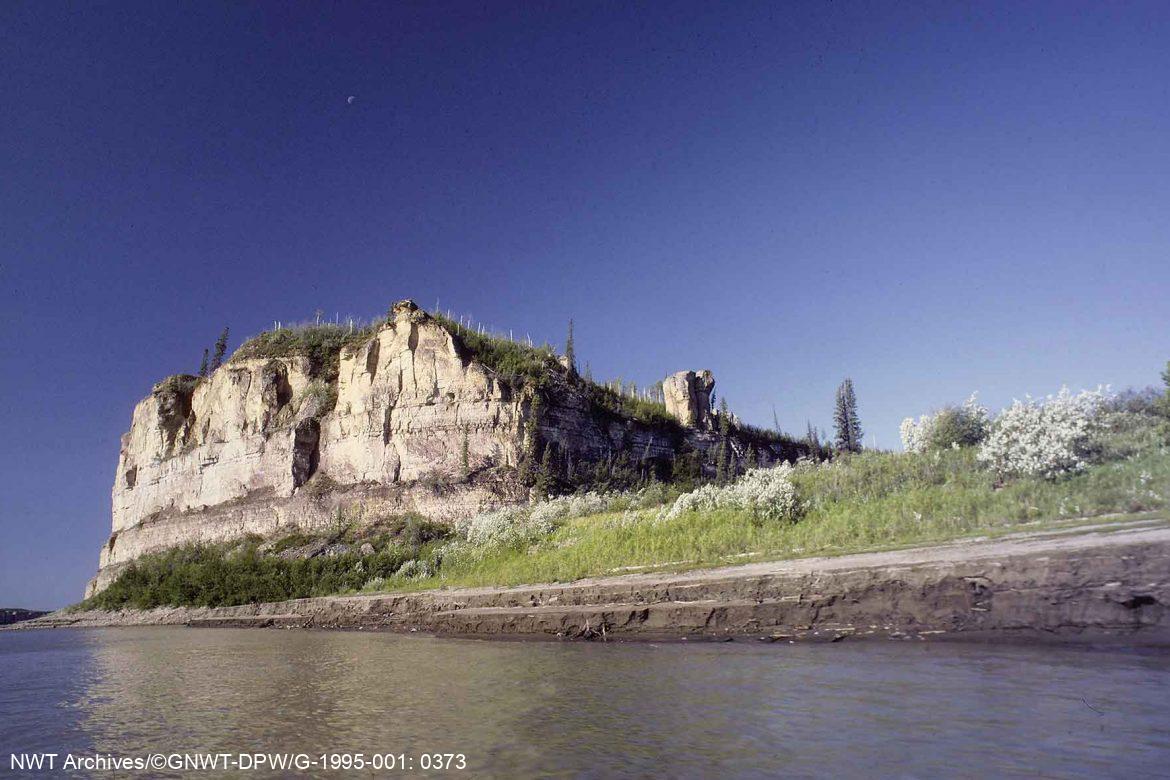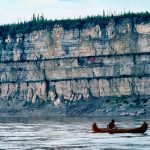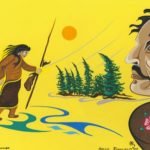Gwich’in
Atachùukąįį and the Giant Ch’ii Choo
Dinjii Zhu’ Ginjik
Niinzhit dài’ gwànoo, aii dinjii nichee diitat nı̀dhı̀zhee dài’, Atachùukąįį zrit Dinjii Zhuh eenjit gwichı̀t nichee iinli’. Yee’ohts’aii nadindye dài’, Atachùukąįį zrit Ch’ii Choo yakàdadhizhee jùu ezhik dài’ dinjii ajaa iinli’. Ch’ii Choo Atachùukąįį yik’ı̀h chı̀lgik gwàt tr’ih tsal hàh yehłat chùuzhii han njı̀’ zhik ts’aii nakhwanankak ts’àt needakak.
Atachùukąįį chuu niint’aii k’ı̀t gwats’àt k’adik dài’, ditr’ı̀i tsal ekhè’ yuunuh. Ezhik danh tth’aih jùk et’et ditr’ı̀i tsal łihts’ee dadhitinh. Atachùukąįį ihłèh nùudye ts’àt nijı̀n gwà’àn nùudye egwideech’in. Duuyeh niinzhit ezhik danh dhidye, Ch’ii Choo yik’ı̀h chilgik geenjit ı̀inch’its’àt uu’àn chùuzhee tęęvęę nji’. Ch’ii Choo yik’ı̀h chùuzhee ts’àt khanh danàa’yųų vik’ı̀ighe’ van nihk’iitik Chii Dą̀įį Zheh gęhnjı̀t gwinjik aii van egwideech’in Nagwichoonjik nji’.
Atachùukąįį zrit aii Ch’ii Choo gàayįį yahtsii kwaa gàh’eedandai’ geenjit nàgwan’ee k’ı̀ighe’ akòo t’àheedi’yaa yuunuh. Ejù’ łǫ̀ǫ Ch’ii Choo shı̀h dhàłkhaih dài’, adik’a’ałtraa guuzhik Atachùukąįį zrit yin’įį ts’àt dizhii uu’àn yinagwineh’ı̀k akòo t’èedi’in’. Nihkhan akòo t’èedi’in’ guuzhik Ch’ii Choo khanh ts’àt datsan k’ı̀ighe’ vat’ą̀įį kwaa nagwijàatth’at. Shı̀h jùhłįį geenjit ditł’į̀į ts’ęįį ts’àt vatthą̀į’ iint’uh ts’àt gàh itsų̀h hàh ałtsąįh.
Ch’ii Choo zrit aii itsų̀h nı̀idhaa nilii geenjit Dzan nı̀ink’oo yahtsii eenjit yuudahkat, yaa’àt srı̀it’ąhthee teetshik zhı̀t nı̀ink’ǫǫ yahtsii t’àheedi’yaa geenjit. Atachùukąįį zrit guk’àt’iiniindhan geenjit aii Dzan yehgǫǫ k’adivik dą̀į’, chii tsal hàh yichı̀lnaii aii Dzan dizhı̀k yichı̀lnąįh. Dzan zrit itsų̀h nàdànalną̀įį aniindhòk Atachùukąįį dinlį̀’ hàh tthak gùunjik ts’àt ajaa.
Dzan zrit Ch’ii Choo aii itsùh eenjit vatr’agwalndak yàhnuu, khanh ts’àt nathitreh. Sree ne’e’ak ts’àt gi’ta’ak chan natanah’yaa kwaa geenjit tr’igwidįį ilik hàh edlii. Aii tł’ee nehsrit t’at datsan k’ı̀ighe’ nàniindhat.
Tsiigèhtshik danh gwàts’at Gabe Andre vagwandak vatr’òonjik.
Atachùukąįį and the Giant Ch’ii Choo
Long ago, in the days when giants roamed the land, Atachùukąįį was a great Gwich’in leader. While travelling in the Yukon, Atachùukąįį met a man-eating giant named Ch’ii Choo. Ch’ii Choo began to chase Atachùukąįį, but Atachùukąįį escaped by canoe, paddling along rivers towards the Northwest Territories.
When Atachùukąįį reached the Ramparts on the Mackenzie River, he left his canoe behind. A large rock that looks like an overturned canoe can be seen there. Atachùukąįį sat down to rest, creating a place that is still indented. He couldn’t rest long because Ch’ii Choo was catching up, so he ran away along the shore. Ch’ii Choo followed, and in six giant steps, he created six big lakes between Fort Good Hope and Norman Wells along the Mackenzie River.
Atachùukąįį knew he could not overpower Ch’ii Choo, so he decided to outsmart him. Every time Ch’ii Choo killed something to eat, Atachùukąįį hid it while Ch’ii Choo was washing. This continued until Ch’ii Choo began to starve. He became so hungry that he cut off a piece of his own backside and made it into pemmican.
Ch’ii Choo wanted to cool the pemmican, so he asked a muskrat to bring it to a nearby creek with cold water. When the muskrat swam by, Atachùukąįį took a rock and hit the muskrat in the mouth. The rat dropped the pemmican, and Atachùukąįį scooped it up with both hands and ate it.
When the muskrat told Ch’ii Choo that he had lost the pemmican, Ch’ii Choo began to cry. He sang a sad song about how he would never see the sunrise or sunset again. Then he starved to death.
Adapted from a story told by Gabe Andre of Tsiigehtchic.



